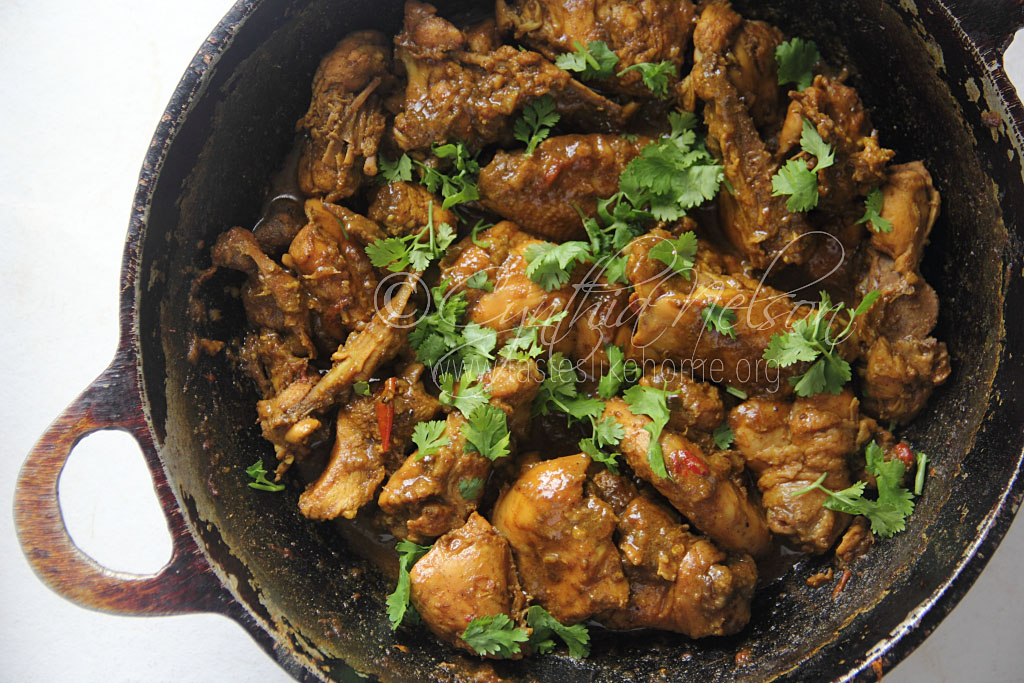 Picking up on the theme from last week, of time and developing flavour, this week I am sharing with you a curry chicken that took, wait for it, 1 hour and 22 minutes to cook. In this case, it wasn’t just about the flavour but the style/ method of cooking.
Picking up on the theme from last week, of time and developing flavour, this week I am sharing with you a curry chicken that took, wait for it, 1 hour and 22 minutes to cook. In this case, it wasn’t just about the flavour but the style/ method of cooking.
We differentiate between a dry curry and one with gravy by calling it bunjal. For the uninitiated, the method of cooking a bunjal type of curry means to cook it slowly in its own juices until all the liquid dries out. What you are left with is meat or poultry coated with the spice paste with which it was cooked. There is no gravy.
There are certain dishes and things that I am always interested in learning different ways in which they are cooked, such as, curry chicken, fried rice, roast chicken, bakes, dhal, breads and rolls, green plantains and the use of coconuts. Therefore, when I saw creative and YouTube content creator Imran Ali’s thumbnail photo: ‘Chicken Masala – No Water Added’, I knew I was going to try making the dish. With his roots firmly planted in Bangladeshi cuisine, the curry caught my eye because the photo showed the chicken coated with a thick sauce. I was curious as to how this bhuna style of cooking was different from our bunjal.
As with many things, each household has its own way of making things. Working off of how I cook and what I learned growing up, when cooking chicken, the bunjal starts with an herb and spice paste sauteed in heated oil until fragrant and cooked through with salt to taste – starting on medium heat and then dropped low. The heat is then turned back to medium high, the chicken added and tossed well to mix with the cooked masala paste. The curry is left to cook for about 5 – 7 minutes and then tossed/turned again. By this time, liquid would have been released from the meat. The pot is covered, the heat reduced to low and left to cook for half an hour.
At the end of the 30 minutes, the cover is removed and things get a toss/turn. The heat is raised to medium and left to cook until the liquid evaporates. The cooking time will vary depending on the amount of chicken being cooked as well as the quality of the meat. By quality, I mean based on how the birds were raised, and processed; some will yield more water than others. How well the meat was drained after washing/rinsing will also have an impact.
This Bangladeshi no-water chicken masala (curry) had a 6-step cooking process. It was about the layering of ingredients and patiently waiting for flavours to develop. All of it building to create a distinct, concentrated flavour to the curry, with a finish of sweet undertones from the onions. Cooked first and the longest, 25 minutes, it was clear that this was a star ingredient in the curry. The spicing in this curry is light and not as pronounced as our curries. Creamy whole milk yogurt is added in the final stage of cooking. The curry is finished with a wonderfully thick creaminess that luxuriously coats the chicken. This curry can be eaten on its own, with rice or with roti. It is not as dry as our bunjal which works best with dhal (unless you are having it as cutters).
It is about a style of cooking and heat regulation is a key “ingredient”. If curry chicken is frequently on rotation in your cooking. Give this version a try.
You’ll need:
● 5 – 6 tablespoons vegetable oil
● 1 cinnamon stick
● 3 tejapatta leaves (Indian bay leaves) or use 1 West Indian bay leaf
● 4 green cardamom pods, crushed
● 1 heaped cup sliced onions
● Salt
● 2 tablespoons ginger-garlic paste
● 3 large tomatoes, each halved
● 2 teaspoons coriander powder
● 1 ½ teaspoons curry powder
● 1 ¼ teaspoons chilli powder
● 1 teaspoon ground cumin/jeera
● 1 teaspoon ground turmeric
● 4 sliced green chilli or chopped hot peppers to taste
● 1 whole chicken cut up for curry
● Salt to taste
● 1 teaspoon garam masala
● 1/3 cup whole milk yogurt, room temperature
● Chopped fresh coriander/cilantro
Here’s how to cook the curry:
1. Add the oil to a pan heated over medium heat. Toss in the cinnamon stick, bay leaf and cardamom pods and let cook for 45 seconds then add the onions and a sprinkling of salt. Stir well and cook for 2 – 3 minutes then add ginger-garlic paste, stir to mix. Cover pan, reduce heat to very low and cook for 20 minutes or until the onions are softened.
2. Remove the cover, raise heat to medium and cook for 5 – 8 minutes so that the onions start to brown a little.
3. Add the tomatoes cut side down on top of the onions, cover and reduce heat to very low and cook for 10 minutes.
4. Remove the cover, pinch the skin off of the tomatoes (use tongs or something else). Using a potato masher or the back of a pot spoon, completely mash the tomatoes mixing it with the onions. Stir and cook together for 2 to 3 minutes.
5. With the heat still on low, add the spice powders (except the garam masala) along with the chilis/hot peppers. Cook for 3 to 4 minutes or until the oil separates (around the edges of the mixture).
6. `Raise the heat to medium and add the chicken along with salt to taste. Toss well with onion-tomato-spice mixture. Cook for 3 minutes then cover, reduce heat to very low and cook for 25 minutes.
7. Remove the pan from the heat and the cover from the pan. Stir the yogurt well into the curry, sprinkle in the garam masala and mix through. Cover and place again over low heat. Cook for 10 minutes.
8. Remove the lid from the pan, raise heat to medium. Add the coriander/cilantro if using. Cook for 2 minutes and remove from heat. Cover, and let rest for 10 to 15 minutes before serving.
NOTES
There should be no need to add any water because of the condensation from the low, slow, covered cooking process. However, if at step # 7, the curry is dry, add a little splash of water (about 2 to 3 tablespoons).
The yogurt must be full-fall or whole milk and be at room temperature so that it does not break when added to the curry.
If there is too much liquid at step # 8, cook a little longer until the curry is creamy with no discernable gravy.
Lemme know what you think if you make it.
Cynthia
cynthia@tasteslikehome.org








